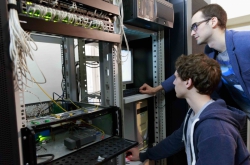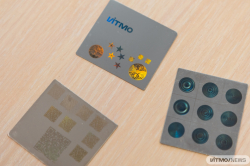The Laser Technology Summer School is an educational crash course: in just four days the students can attend a dozen lectures, pay a visit to some of ITMO’s research labs and its production area to personally witness how lasers are applied in real life. The high-schoolers also learned about the history and the structure of a laser and about its various uses. For example, optoelectronic devices can be used to determine the freshness of foodstuffs, study antique paintings, detect gravitational waves, identify the biological make-up of a substance, among other things. The students were also told about the use of lasers in nanotechnology. As is tradition, the Summer School’s lecturers were students and postgraduates of ITMO University who specialize in the subject. Those wishing to present their materials to the high-schoolers have to pass a selection process.

“The main purpose of the school is career guidance. We want to show these students that lasers aren’t just toys for cats and lightsabers. Most schools don’t teach that to kids. The laser was invented in mid 20th century, but it is now that laser technology is becoming more and more advanced; there are few things that aren’t done using lasers these days. We want the kids to get an impression of the industry so that when they return to the university, they are already aware of where they’re heading and what results they can expect. Besides, laser technology is one of ITMO University’s primary fields of educational and entrepreneurial activity,” – explains Alexey Itin, deputy dean at Faculty of Laser and Light Engineering.

In addition to lectures, the Summer School’s attendants could see the university’s scientists and students use laser technology in practice. They paid a visit to OptiLAB, where students dabble in optoelectronic engineering and work on various projects. They were also given a tour of the Laboratory of Laser Nano- and Femtotechnology. At the recently-founded Open Academy of Laser Microtechnologies the students could learn about the inner workings of laser and measuring devices: femto- and picosecond, excimer, fiber and CO lasers; optical microscopes, interferometers, spectrometers and even a robotized laser jet. The “Open” part of the name implies that the lab equipment can be accessed not only by the university’s staff and students, but by school students and industry experts who wish to hone their skills there. The Academy’s partner in the industry is JSC “Laser Center” – a company that integrates laser technology into various enterprises. The high-schoolers were also invited to the company’s plant. Finally, at ITMO’s Museum of Optics, they learned about holography and saw how optics are used in art.

“At the plant, the students were able to witness how lasers are used in today’s world. Later, during the lectures, they found out about the future of laser technology. Now that we’ve planted the seed of interest, they will go back to their schools and tell their friends about what they’ve seen and maybe get them interested, too,” – notes Mr. Itin.
The Laser Summer Schools also serves as an introduction for the year-long Laser Technology School also organized by ITMO University. During the first half of the course, the school’s students come to the university each Saturday to learn about laser technology. In the second half, they unite with Master’s and postgraduate students on actual scientific projects and conduct measurements, computations and experiments. The students then present their results at the Congress of Young Scientists; those who garner the most praise at the congress go on to showcase their projects at the International Symposium “Fundamentals of Laser Assisted Micro– and Nanotechnologies” (FLAMN).

This year’s Summer School was attended by 36 high-schoolers. We asked them what they’ve learned, why they decided to dedicate a part of their summer holidays to science and how they see the future of laser technology.
Alina Korchilava, grade 10, Lyceum №64
Before coming here, I also attended the Management School and Biotechnology School. I’m interested in technology in general, but I also wanted to see what management is all about and whether I’d be into it. I realized that I’m not. I only learned about the Laser Technology School by accident and applied at the very last moment; I am very glad that I did. In school, this topic is barely taught and they only talk about the theoretical parts of it. Still, I found the lectures here at ITMO University accessible since they are presented in terms understandable to schoolkids. In just two days I’ve learned a lot about lasers. I’ve seen them in action for the first time and learned about their uses. I’m certain that I’d love to keep learning about lasers, as it is something that I’m good at and it interests me, too. In addition, laser technology is on the rise right now and it’s a very relevant field of study. I’ll continue taking part in ITMO University’s events for school students and will do my best to enroll here.

Georgiy Litin, grade 9, School №296
At the Laser Technology Summer School, they tell you about the various kinds of lasers, how they’re used and why – it’s all pretty interesting to me. I learned a lot of new things about holography in the Museum of Optics. I’d love to keep studying laser technology. I’m still not sure which exact specialization profile to pick, but I’m certain that ITMO’s academic staff will help me find my way. I like the atmosphere here; there are lots of programs for schoolkids here and even a sports club. I’m an athlete myself and I’d love to join it once I enroll at the university.

Valentin Kulakov, grade 10, School №345
I learned about the Summer School from my physics tutor and thought, hey, why not give it a try? Instead of procrastinating on my summer holiday, I’d rather not waste time and learn something I’d never learn at school. I’m into physics and computer science; I decided to study lasers as this technology may boost the development of new devices and applications. They can be used anywhere: criminal science, medicine, holography. I think holography has great potential. Sure, it might not be as useful for society as, say, medicine. But, on the other hand, it can be used in telecommunications or to create different visuals. During the lectures we were told that in future, we will even be able to touch holographic images. This would let people visit places they’ve never been to, see remote sights. Overall, the Summer School taught me a lot about how lasers can be applied and why one day they will become an integral part of everyday life.






